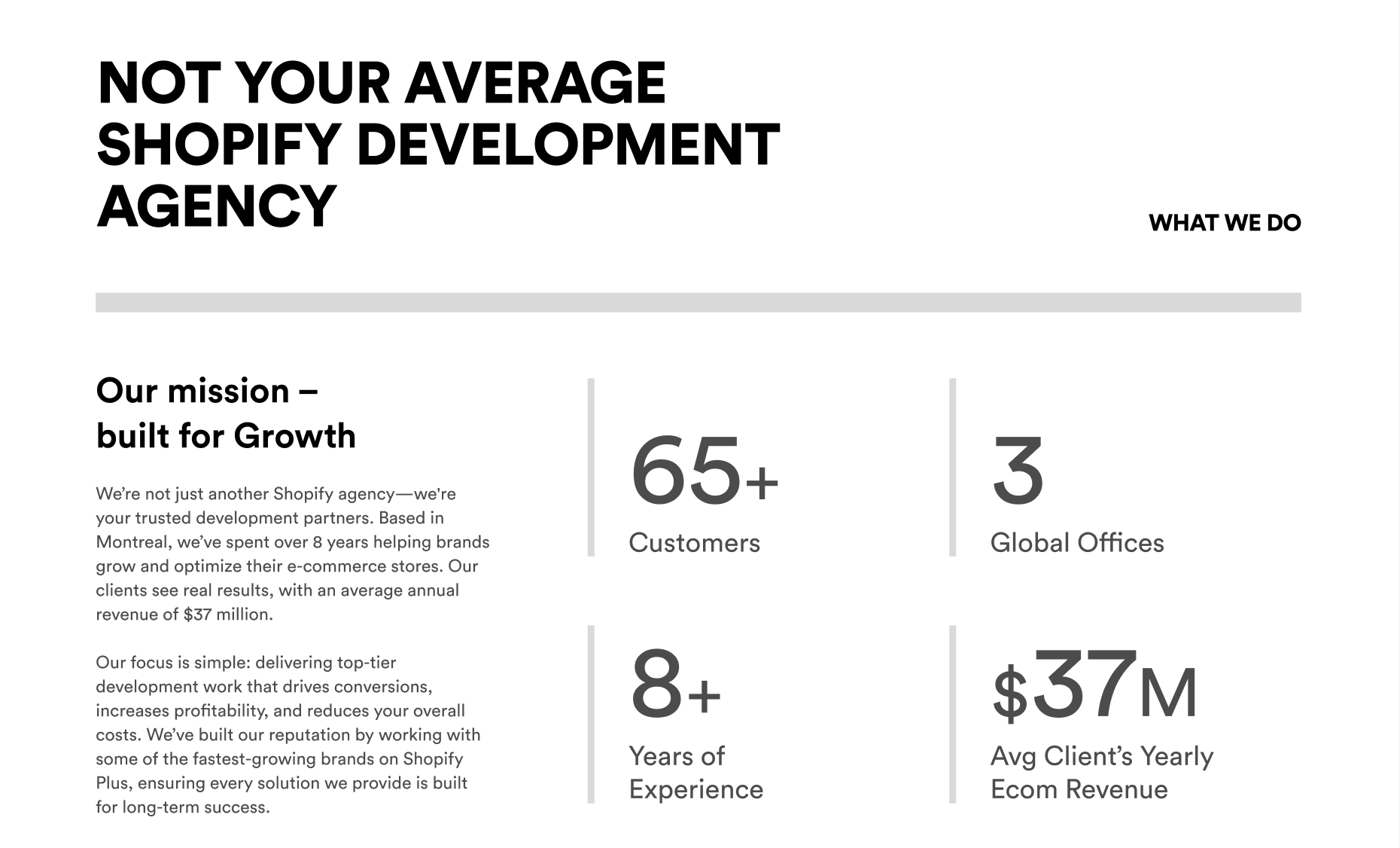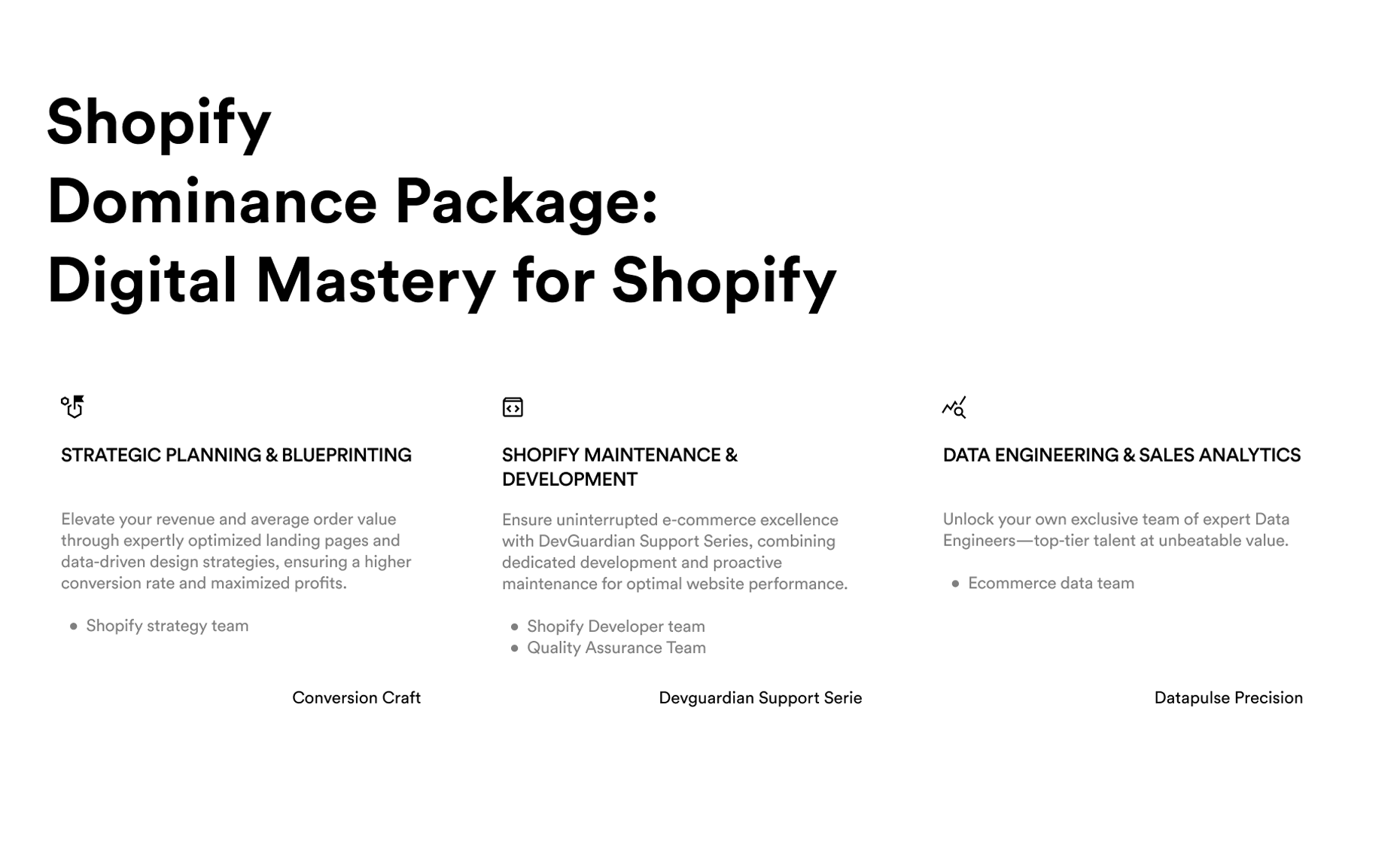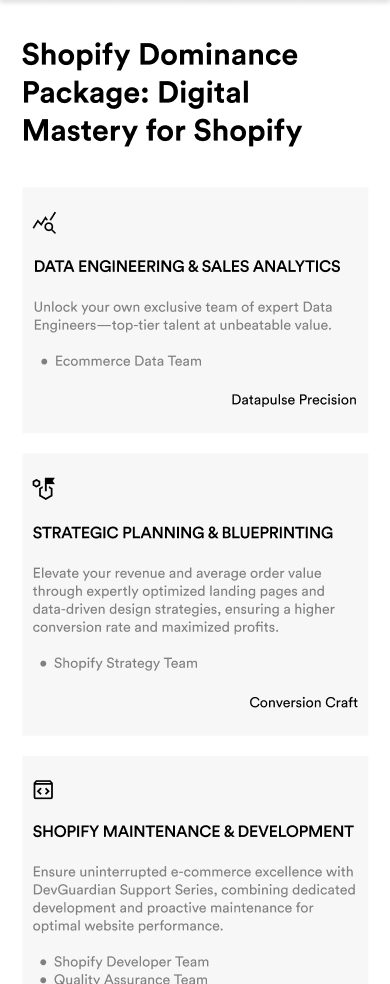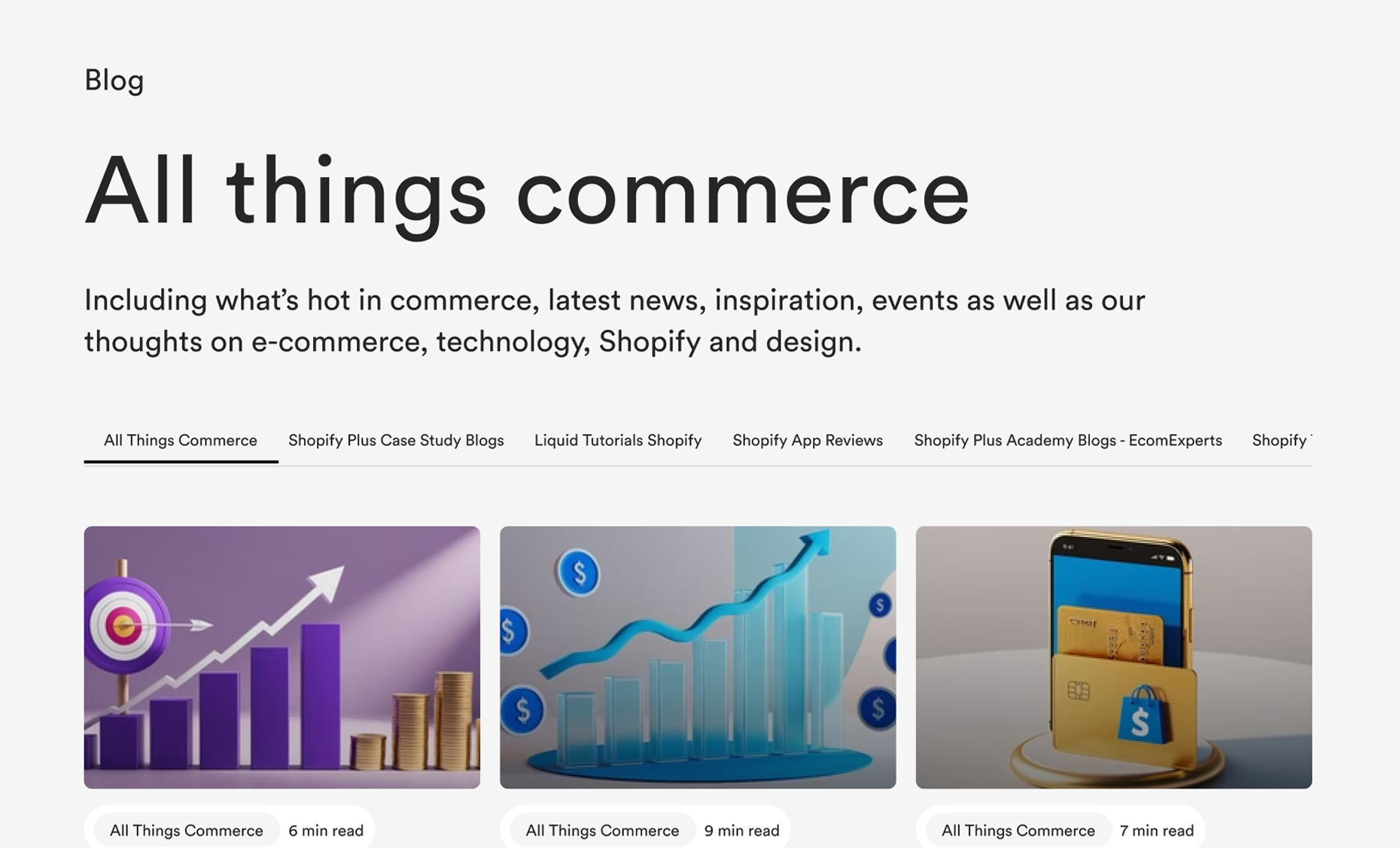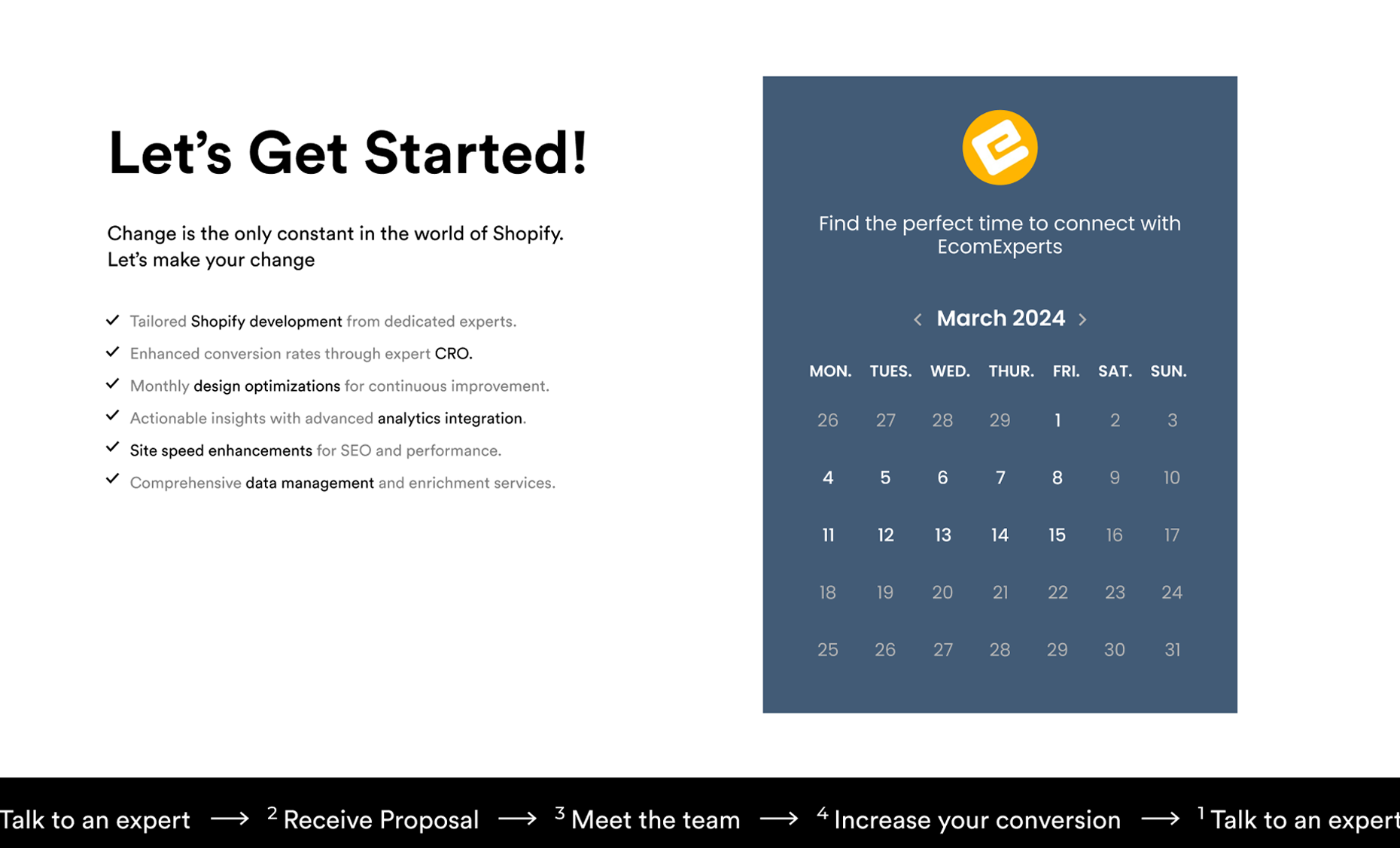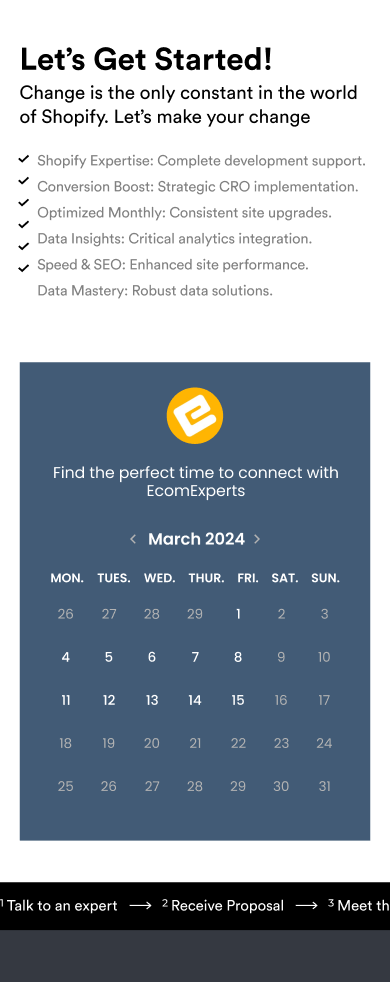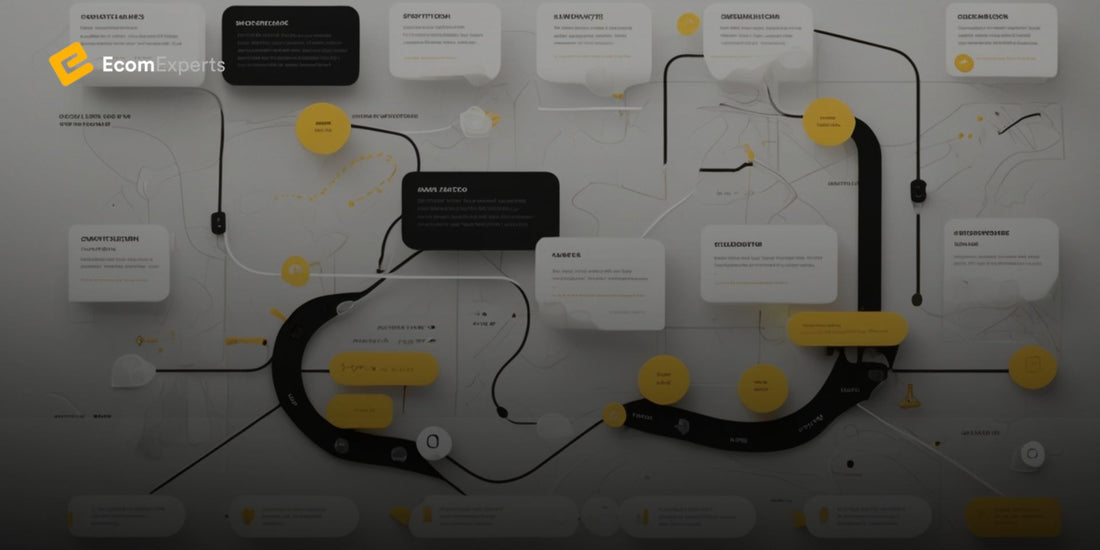You’ve probably spent hours trying to figure out how to make your Shopify store stand out. You’ve invested in ads, optimized your product pages, and even dabbled in email marketing. But, here's the thing: if you’re not mapping your user journey, you’re missing out on a massive opportunity to boost sales and improve customer retention.
In this blog, we’re going deep. We’re talking about creating a user journey map that not only helps you understand the flow of your customers but also allows you to fine-tune every step they take. And no, this isn’t just another “nice to have.” Shopify stores that map out their user journeys are crushing it, leaving competitors in the dust.
So, if you want to be in the game—and more importantly, win it—understanding how your users behave from landing on your site to hitting that ‘Buy Now’ button is everything.
The Role of User Journey Mapping in E-commerce
Now, why does this matter so much in 2024? Glad you asked. With Google’s latest algorithm updates earlier this year, websites that deliver better user experiences are now prioritized in rankings. What does that mean for you? If your site is clunky or hard to navigate, Google’s gonna push you down the results page faster than you can say “SEO.”
User journey mapping is the tool that helps you understand where your users are getting stuck and how you can make their path to purchase as smooth as butter. Imagine being able to see exactly where they bounce, why they abandon their carts, and what makes them convert.
By understanding this, you're not only creating a more seamless experience for your customers but also improving your SEO. Win-win, right?
Why Your Shopify Store Needs a User Journey Map
If you want to reduce cart abandonment, boost conversions, and create loyal customers, then a user journey map is your secret weapon. Think of it like this: it’s the blueprint to your customers' behavior. When you have that blueprint, you can fix the pain points that are costing you sales.
Whether it's a glitchy checkout page or a confusing product description, journey mapping shows you where the problems are—so you can fix them and drive up revenue.
But let’s not forget: this isn’t just about getting that one-time sale. It’s about creating a memorable experience that keeps your customers coming back. Shopify stores with optimized user journeys see higher conversion rates, better customer retention, and a big ol' boost in customer lifetime value. At the end of the day, this is about building relationships—not just racking up transactions.
What is a User Journey Map?
In simple terms, a user journey map is a visual representation of the steps a customer takes to achieve a specific goal while interacting with a product, service, or brand. It helps you understand what users experience at each touchpoint—from discovering your brand to making a purchase or becoming a loyal customer. Think of it as a roadmap that traces the emotions, motivations, and behaviors a user experiences throughout their interaction.
Breaking down this concept further, the map typically includes phases such as awareness, consideration, decision-making, and post-purchase, helping you grasp a full spectrum of the user's experience. The more detailed you make this map, the better you can understand the needs and pain points that customers encounter on their journey.
Why It’s Important?
A user journey map is essential because it allows you to identify potential roadblocks and areas of friction that users may experience on your site. It goes beyond surface-level data and dives into how users feel and react at various touchpoints, helping you make decisions that can improve user experience.
On platforms like Shopify, understanding your user's journey can help you optimize conversion rates, reduce cart abandonment, and create more meaningful interactions with your audience.
Studies have shown that 86% of buyers are willing to pay more for better customer experience . If your store offers a smooth and intuitive journey, your brand is more likely to succeed.
User Journey Map vs. User Flow
It’s easy to confuse user journey maps with user flows, but they serve different purposes.
-
User journey maps focus on the entire experience a user has when interacting with your brand, from the very first touchpoint to becoming a repeat customer. It’s all about the experience and the emotional journey.
-
User flows, on the other hand, are more task-oriented. They break down specific actions, like signing up for an account or completing a checkout process. It’s about mapping the most efficient way to guide a user through a specific task.
In short, while both help you understand user behavior, user journey maps give you a big-picture view of the user’s experience, and user flows focus on optimizing specific tasks within that journey.
Example
Let’s visualize a basic user journey map. Imagine you’re an online retailer selling premium workout gear. Your user journey map might look something like this:

- Awareness Phase: User discovers your brand through social media ads.
- Consideration Phase: User browses your Shopify store, comparing products.
- Decision Phase: User adds items to their cart, reviews shipping options.
- Purchase Phase: User completes the checkout process.
- Post-Purchase Phase: User receives email updates and considers leaving a review.
This map allows you to see the entire journey, pinpoint where users may be dropping off, and strategize improvements—whether that’s simplifying the checkout process or enhancing your post-purchase engagement.
Benefits of Using a User Journey Map
Customer Experience Optimization
A user journey map gives brands a clear picture of the customer experience from start to finish. By understanding exactly where users are encountering friction, brands can refine processes and eliminate pain points. The ability to visualize every touchpoint—whether it's a slow-loading product page or confusing navigation—helps store owners optimize each step for a smoother, more intuitive experience.
A Forrester report notes that companies that focus on improving the customer journey see a 20% increase in customer satisfaction and 15% reduction in customer churn .
Boost Conversions
Identifying critical drop-off points through journey mapping allows you to address the areas where users abandon their carts, lose interest, or hesitate. By eliminating these friction points, you can effectively boost conversion rates.
For example, if a user abandons the cart during the checkout process, mapping the journey can highlight a cumbersome payment system or unexpected shipping costs as the culprit, providing you with actionable data to fix these roadblocks and improve checkout completion rates.
Enhanced Engagement & Retention
When you tailor the customer journey to match user expectations, you foster deeper engagement and improve retention. User journey maps allow you to understand not just what your users are doing, but why they’re doing it, allowing you to craft personalized experiences that increase customer loyalty and reduce churn.
McKinsey reports that customer-centric companies are 60% more profitable than those that don’t focus on customer experience . Enhancing this experience through targeted engagement is key to turning one-time shoppers into repeat buyers.
SEO Benefits
In 2024, Google’s algorithm places a high priority on websites that offer an intuitive, seamless user experience. User journey mapping directly impacts your SEO performance by improving core metrics like bounce rate, time on site, and user engagement.
A more optimized journey means that users spend more time on your site, engage with your content, and are more likely to return—all factors that boost your rankings in search results. According to a study by SEMrush, websites with better user experiences have 50% higher engagement metrics, leading to improved organic visibility .
Data-Driven Insights
At its core, user journey mapping is a data-driven exercise. It’s not just about creating a visual of the journey; it’s about using real-time behavioral data to understand how users interact with your brand.
By tracking metrics such as page views, cart abandonment rates, and conversion paths, store owners can make informed decisions about where to invest in improvements. These insights offer a clear roadmap for growth, ensuring that you’re optimizing your store based on actual user behavior rather than assumptions.
Essential Elements of a User Journey Map
Buyer Persona Creation
The foundation of any successful user journey map starts with creating detailed buyer personas. These personas represent your target audience, reflecting their demographics, behaviors, goals, and challenges.
To effectively map the customer journey, you must first understand who your customers are. Start by gathering data through surveys, analytics, and interviews. Ask questions like:
What are their pain points? What motivates them to make a purchase?
According to HubSpot, 71% of companies that exceed their revenue and lead goals use personas to guide their marketing strategies. By using this data, you can develop personas that drive your marketing and user experience strategies.
Stages of the Journey
A user journey map typically covers five major stages: Awareness, Consideration, Purchase, Post-Purchase, and Retention.
- Awareness: The stage where the user becomes aware of a problem or need. At this point, they're conducting research and exploring options.
- Consideration: Here, users evaluate different solutions, compare prices, and look for reviews. They weigh the pros and cons before making a decision.
- Purchase: The user takes action—whether it's completing an online purchase, signing up for a service, or making a direct inquiry.
- Post-Purchase: At this stage, the goal is to ensure that users are satisfied, reducing buyer's remorse. Follow-up emails, feedback requests, and loyalty programs play a role here.
- Retention: Finally, keeping the customer engaged long after their first purchase, through content, personalized offers, or exclusive rewards, builds long-term loyalty.
Breaking down these stages helps you anticipate user actions, emotions, and the information they might seek at each step. Knowing these stages also allows you to create content tailored for each phase.
Touchpoints
A touchpoint refers to any interaction or encounter that a user has with your brand. For e-commerce businesses, these can range from website visits, social media ads, emails, customer service, or even word-of-mouth recommendations. Mapping these critical touchpoints across the user journey ensures that you meet your users wherever they are.
If a customer engages with your social media but has difficulty navigating your website, that disconnect could cost you conversions. A well-mapped journey allows for a seamless experience across all touchpoints, aligning your messaging and branding consistently.
Emotions and Pain Points
Understanding the emotions and frustrations of your customers is critical for designing a successful user journey. Every stage of the journey is loaded with emotional triggers, whether it’s excitement during the consideration phase or frustration at a complicated checkout process.
Identifying these emotions helps you recognize pain points—the places where the experience breaks down, leading to drop-offs, cart abandonment, or low engagement. For instance, a study by the Baymard Institute shows that 69% of online shopping carts are abandoned, often due to a complicated or unclear checkout process.
User Goals & Motivations
Your customers have specific goals and motivations that drive them to engage with your brand. Whether they’re seeking a solution to a problem or trying to fulfill a need, understanding these goals allows you to align your products, services, and marketing efforts with their desires.
For example, if a user’s goal is to find a quick, affordable solution, but your site is loaded with unnecessary information or upsell prompts, you’re likely to lose them. Understanding your audience's motivations and focusing on how to meet those needs efficiently is key to keeping them engaged.
Creating a User Journey Map for Shopify Stores
Step 1: Research & Data Collection
Before diving into user journey mapping, the first essential step is collecting accurate customer data. This data gives you a clear picture of how visitors interact with your Shopify store. Tools like Google Analytics offer insights into user behavior, such as which pages users visit most, how long they stay on each page, and where they drop off.
Heatmaps from services like Hotjar help visualize where users are clicking, scrolling, or getting stuck. Additionally, customer feedback surveys are invaluable for getting firsthand insights into frustrations or positive experiences. A data-driven approach ensures that your user journey map is grounded in reality, not assumptions, and can highlight gaps or opportunities that may otherwise go unnoticed.
Step 2: Identify Key Touchpoints
Touchpoints are the specific interactions a customer has with your Shopify store, both online and offline. Identifying these touchpoints is crucial for creating a comprehensive user journey map. For Shopify stores, these touchpoints may include:
- Website interactions: Landing pages, product pages, checkout flow, and post-purchase experiences.
- Email marketing: Automated emails, abandoned cart reminders, or order confirmations.
- Social media: Ads, organic posts, and engagement with customer support via direct messages.
- Customer support: Live chat, phone support, or FAQs.
Don’t forget offline touchpoints, such as in-store experiences (if applicable) or events. Consistency across all touchpoints is key for maintaining brand trust and delivering a unified experience.
Step 3: Mapping the Customer’s Emotions and Actions
The emotional state of the customer at each touchpoint is as important as their physical action. Each stage of the customer journey evokes different emotions, and these can either enhance or hinder their experience. Here’s a simplified framework:
- Awareness stage: Customers might feel curiosity or uncertainty as they discover your brand.
- Consideration stage: Excitement or confusion as they weigh their options.
- Purchase stage: A mix of confidence or hesitation, depending on the clarity and ease of the checkout process.
- Post-purchase: They may feel delight if the product arrives on time, but frustration if it doesn’t meet expectations.
Document these emotions and pair them with the specific actions the customer is taking. For example, during checkout, they might be comparing prices or reading reviews, while feeling nervous about whether your store is trustworthy.
Step 4: Visualizing the Journey
Once you have your touchpoints and customer emotions mapped out, the next step is visualizing the entire journey. You want the map to be clear, intuitive, and accessible, especially if you're using it to communicate with your team. Tools like Lucidchart or UXPressia offer templates that make it easy to create a user-friendly map.
Start by dividing the map into each stage of the journey (Awareness, Consideration, Purchase, etc.), and under each stage, list the touchpoints, customer emotions, actions, and any key challenges or opportunities. This visual representation will give you a holistic view of the user's path, making it easier to spot areas that need improvement or optimization.
Step 5: Analysis and Action
A user journey map is only as useful as the insights and actions you derive from it. Once your map is complete, it's time to analyze the gaps, opportunities, and bottlenecks in the customer experience. Are users abandoning their carts at checkout? Is your product page missing key information that leads to hesitation? Maybe your post-purchase communication lacks follow-up, affecting retention.
Once you've identified these weak points, take actionable steps to optimize them. If users consistently drop off at the checkout, for example, consider simplifying the process or offering a guest checkout option. In 2024, optimizing these key touchpoints is crucial for boosting conversions and enhancing the overall user experience.
Common Pitfalls When Creating a User Journey Map
Focusing Too Much on the Product
One of the biggest mistakes businesses make when creating a user journey map is over-focusing on their product rather than the entire customer experience. While your product is essential, understanding your customer’s broader needs, challenges, and goals is even more crucial. Brands that zero in on product features tend to overlook the emotional, informational, and contextual elements that drive a customer to make a purchase.
A successful journey map needs to consider the user's holistic experience, from how they find your brand to how they interact with customer service post-purchase. Shopify store owners, in particular, must realize that customers aren’t just looking for a product—they're seeking solutions, trust, and a seamless experience.
For instance, if your Shopify store sells apparel, focusing exclusively on the fabric and design of your products misses the point. Instead, look at the customer's journey: What made them land on your site? What concerns might they have about fit, return policies, or delivery times?
Focusing on their overall purchase motivations rather than just the product allows you to create a more effective and user-centric journey map.
Ignoring Emotional Touchpoints
In e-commerce, emotions drive purchasing decisions. According to a study in 2024, 95% of purchasing decisions are influenced by subconscious emotional reactions. Ignoring how your users feel at every stage of the journey can lead to a disjointed or even frustrating experience.
If your Shopify store fails to address emotional touchpoints—whether that’s building excitement in the discovery phase or offering reassurance at checkout—you could be losing potential sales.
Think about the user's emotional journey: from excitement during the product search, to anxiety before entering payment details, to satisfaction (or disappointment) after the product is received.
Mapping out emotional highs and lows is crucial for understanding pain points and areas where you need to offer better support, reassurance, or delight.
Lack of Continuity Across Channels
Another common pitfall is inconsistent messaging and experience across different touchpoints, such as your website, email campaigns, social media, and customer service interactions. In today’s digital landscape, users engage with your brand across multiple platforms and expect a seamless experience throughout.
If your Shopify store promotes fast delivery on your website but your post-purchase emails fail to reflect that, users may feel confused or mistrustful.
Maintaining continuity means that your brand messaging, tone, and service levels must remain consistent whether the user is interacting with your Instagram post, reading your product description, or responding to your customer support.
This continuity fosters trust and reduces friction, ultimately improving conversions. A 2024 Salesforce study revealed that 76% of consumers expect consistent interactions across departments and platforms. When building a user journey map, it’s critical to account for every platform where your brand engages with customers, ensuring they receive a uniform experience.
How to Continuously Optimize Your User Journey Map
Data-Driven Adjustments
In 2024, data is more important than ever in refining the user experience, and your user journey map is no exception. The process of creating an effective user journey map doesn’t end once it's plotted out—it’s a dynamic tool that must evolve as your business and your customers change.
Shopify store owners need to rely heavily on real-time analytics from tools like Google Analytics, Hotjar, or even Shopify’s built-in analytics dashboard to track user behavior and engagement. This allows you to continually gather insights on how users are navigating your store, what’s converting, and where they drop off.
When analyzing data, focus on key metrics such as bounce rate, conversion rate, time on site, and user flow paths. These metrics offer a wealth of information that can inform which areas of the customer journey need tweaking. Regularly analyzing these numbers allows you to adjust the map to reflect new behavior patterns, ensuring that your customer journey remains smooth and optimized for conversions.
Customer Feedback Loops
Another critical factor in keeping your user journey map updated and optimized is listening to your customers through feedback loops. Direct customer feedback offers first-hand insights into the pain points and highlights in your store's experience that even your data might miss. Set up post-purchase surveys, NPS (Net Promoter Score) ratings, live chat reviews, or simple email follow-ups to capture this invaluable feedback.
Collecting and integrating this data ensures you stay in sync with customer expectations, helping you build a more intuitive and streamlined user journey. Shopify’s native email and app integrations make it easy to automate these feedback loops. Tools like Klaviyo or Typeform are great for triggering feedback requests at key touchpoints, giving you real-time insights into what's working and what isn't.
Regular Audits
It's essential to conduct regular audits of your user journey map. Why? Because customer behavior evolves, especially in the fast-moving world of e-commerce.
Your Shopify store may introduce new products, your target audience may shift, or external factors like Google’s algorithm updates could affect how customers interact with your site. As a result, your user journey map can quickly become outdated if not regularly reviewed and optimized.
A comprehensive audit should involve reviewing all customer touchpoints—such as landing pages, checkout flows, and support channels—and ensuring they align with the latest SEO best practices, business objectives, and customer needs.
Furthermore, these audits help uncover friction points that might have been overlooked during the initial mapping process, giving you an opportunity to improve the experience.
A/B Testing
Finally, one of the most effective ways to continuously optimize your user journey map is through A/B testing. This process involves running controlled experiments to test specific elements of the customer journey, such as email subject lines, homepage layouts, product descriptions, or checkout page designs.
By creating two variations of a page or touchpoint and testing them against each other, you can determine which version performs better in terms of conversion, engagement, or retention.
For example, testing two versions of your Shopify cart abandonment email can reveal which subject line leads to higher open rates, or which call-to-action gets more customers to complete their purchase.
Tools like Optimizely make A/B testing simple and scalable, allowing Shopify store owners to test and improve user journey elements continually.
Regular A/B testing ensures you aren’t relying on assumptions and can base decisions on hard data, continually fine-tuning each touchpoint for maximum efficiency.
Why Every Shopify Store Owner Needs a User Journey Map in 2024
In today’s hyper-competitive e-commerce landscape, having a user journey map is not just a "nice-to-have"—it’s essential. A well-constructed user journey map allows Shopify store owners to deeply understand how their customers interact with their brand at every touchpoint.
From the first time a customer visits your site to when they complete a purchase (and beyond), a user journey map gives invaluable insights that can drive better business outcomes.
Why does this matter in 2024? Because customer experience has become the differentiator. Google’s March 2024 algorithm updates make it clear: user experience is king. A smooth, intuitive, and optimized user journey doesn’t just boost your site’s SEO ranking; it directly leads to higher conversions, better engagement, and improved retention.
When you reduce friction and make the buying process seamless, customers are more likely to complete their purchases, leave positive reviews, and return for repeat business.
Whether you’re a brand owner or running a Shopify store, investing in user journey mapping helps you spot pain points, understand your customers on a deeper level, and ultimately create a more profitable business.
As Shopify continues to grow as a platform for brands to thrive, building that seamless experience will become a crucial part of staying competitive.
Ready to Optimize Your Shopify Store?
Take the first step in transforming your store’s customer experience by reaching out to Ecom Experts. Our Shopify specialists can help you create or optimize your user journey map, ensuring every touchpoint delivers maximum value for your business.
FAQ
Q1. What is a User Journey Map, and why is it important for Shopify stores?
A1. A User Journey Map visually represents the steps your customers take from discovering your Shopify store to making a purchase. It’s crucial because it helps you understand user behavior, optimize their experience, and identify roadblocks that could prevent conversions. For Shopify stores, this can significantly boost customer satisfaction and drive higher sales.
Q2. How do I create a User Journey Map for my Shopify store?
A2. Creating a User Journey Map involves several steps: start by collecting data on customer behavior using tools like Google Analytics, identify key touchpoints (website, social media, emails), map out customer emotions and actions, and visualize the journey using tools like Lucidchart. Continuously analyze and optimize to refine the customer experience.
Q3. What are the benefits of using a User Journey Map for e-commerce?
A3. A User Journey Map helps e-commerce businesses, including Shopify stores, optimize the customer experience, boost conversion rates, and enhance engagement and retention. Additionally, it provides valuable data-driven insights that help improve marketing strategies and product offerings, all while aligning with Google's SEO emphasis on user experience.
Q4. What’s the difference between a User Journey Map and a User Flow?
A4. While both are important for Shopify stores, a User Journey Map focuses on the overall customer experience, including their emotions and motivations at each touchpoint. A User Flow, on the other hand, details the specific steps a user takes to complete a task, such as making a purchase or signing up for a newsletter.
Q5. How can a User Journey Map improve SEO for my Shopify store?
A5. Improving the user journey directly impacts SEO. Google’s 2024 algorithm favors websites that offer seamless and intuitive user experiences. By reducing bounce rates, increasing time on site, and offering a smoother navigation experience, a well-crafted user journey map can enhance your Shopify store's search engine ranking and drive more organic traffic.




